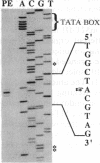Abstract
A third member of the metallothionein (MT) gene family, designated MT-III, was cloned by virtue of its homology to a human protein that was shown previously to inhibit neuronal survival in culture and to be deficient in the brains of people with Alzheimer disease. Human and mouse MT-IIIs have two insertions relative to all other known mammalian MTs: a threonine after the fourth amino acid and a block of six amino acids near the carboxyl terminus. The genes encoding MT-III resemble all other mammalian MT genes in their small size and exon/intron organization. The MT-III genes are closely linked to the other functional MT genes on human chromosome 16 and mouse chromosome 8. Mouse MT-III gene expression appears to be restricted to brain; in addition, it fails to respond to zinc, cadmium, dexamethasone, or bacterial endotoxin in vivo, thereby distinguishing MT-III from other known MTs.
Full text
PDF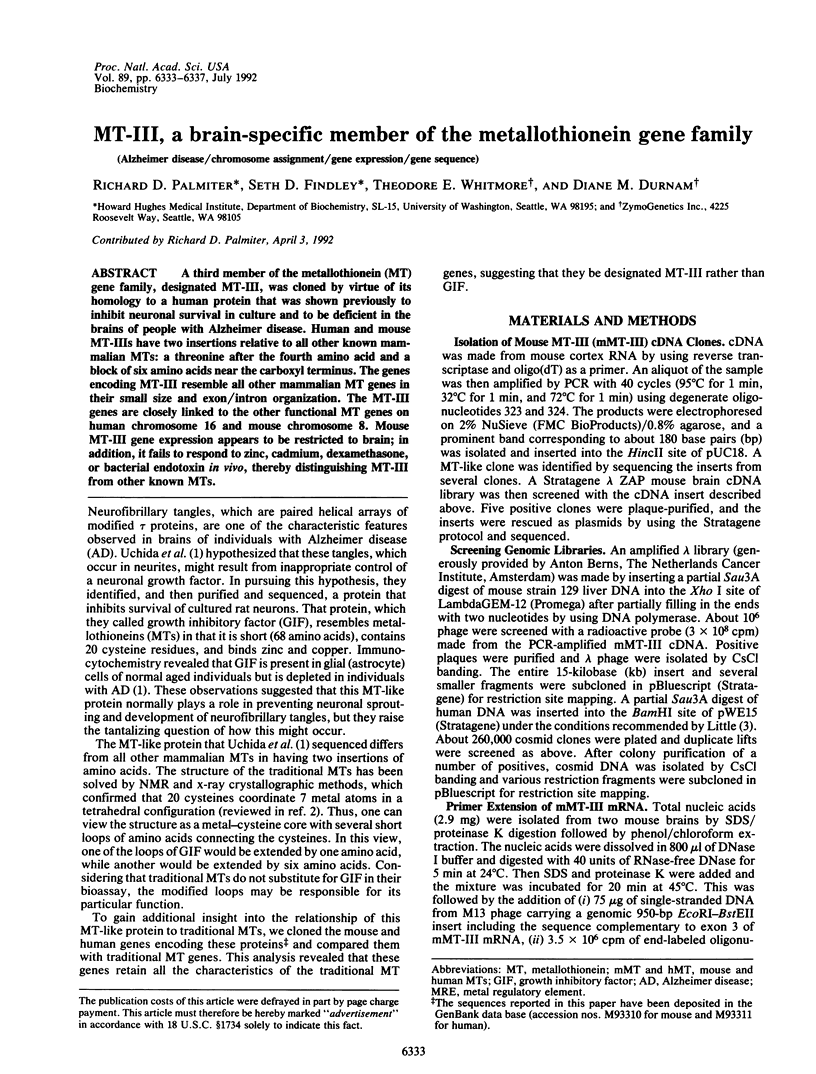
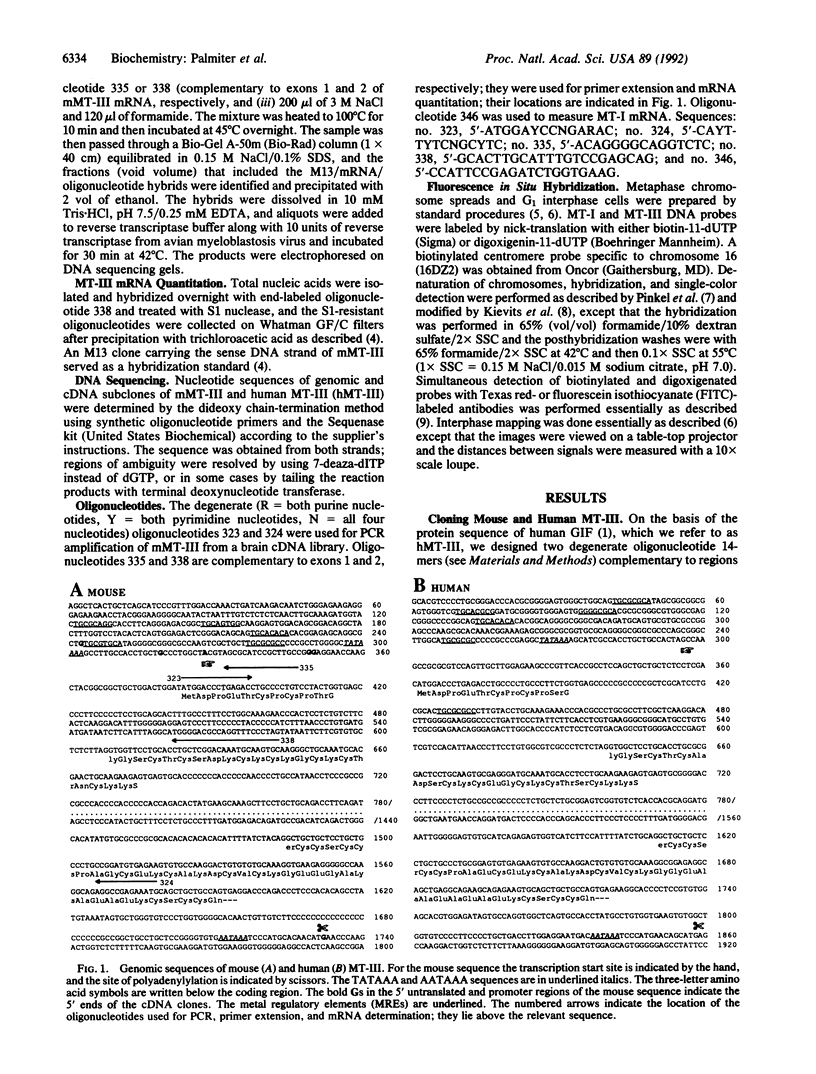
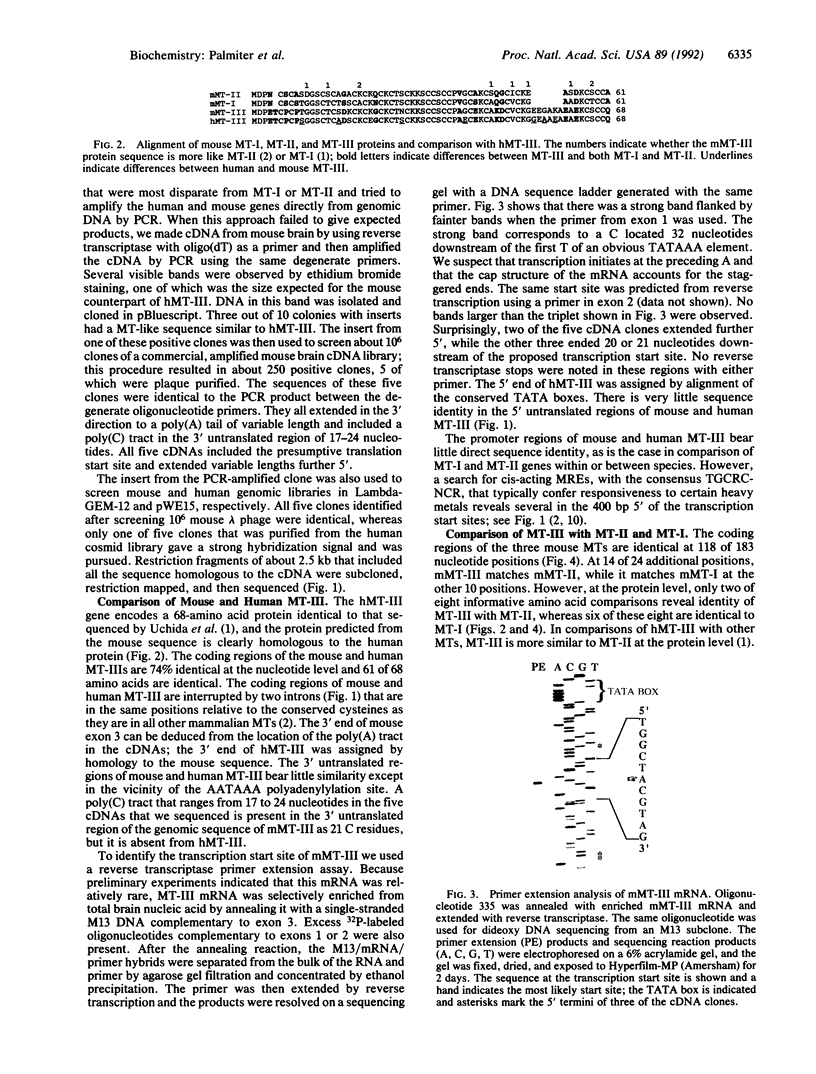

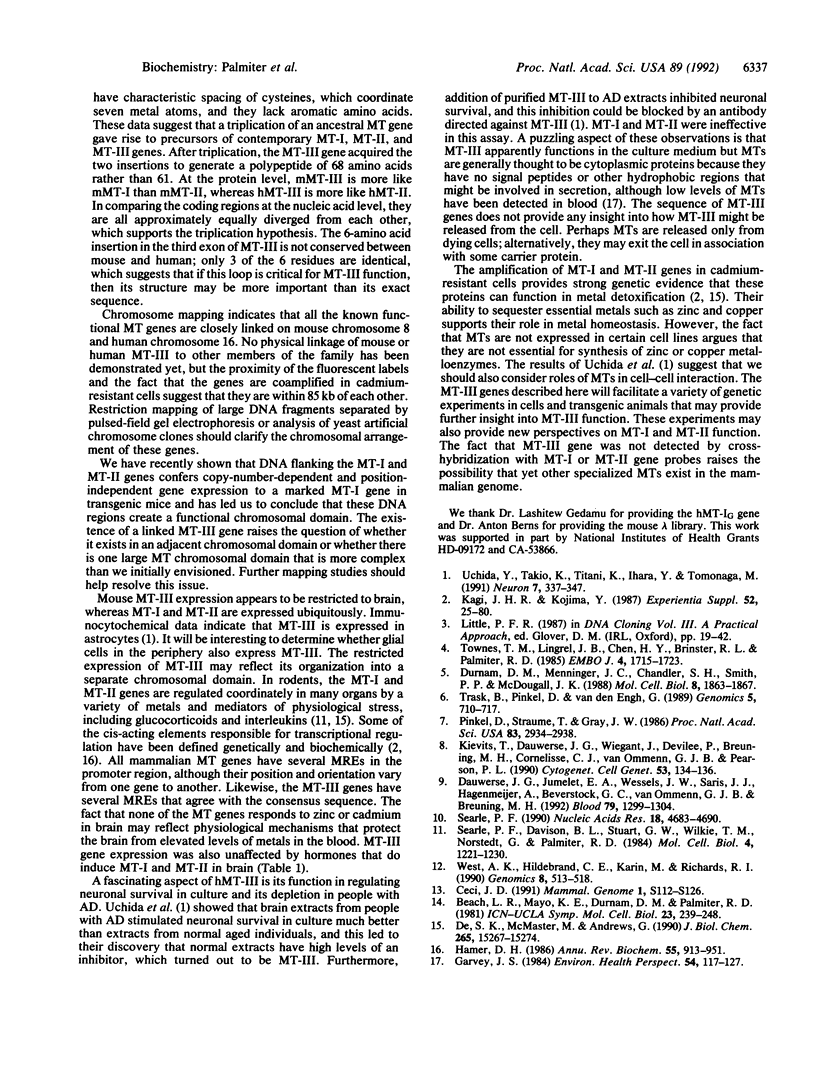
Images in this article
Selected References
These references are in PubMed. This may not be the complete list of references from this article.
- Ceci J. D. Mouse chromosome 8. Mamm Genome. 1991;1(Spec No):S112–S126. doi: 10.1007/BF00656489. [DOI] [PubMed] [Google Scholar]
- Dauwerse J. G., Jumelet E. A., Wessels J. W., Saris J. J., Hagemeijer A., Beverstock G. C., van Ommen G. J., Breuning M. H. Extensive cross-homology between the long and the short arm of chromosome 16 may explain leukemic inversions and translocations. Blood. 1992 Mar 1;79(5):1299–1304. [PubMed] [Google Scholar]
- De S. K., McMaster M. T., Andrews G. K. Endotoxin induction of murine metallothionein gene expression. J Biol Chem. 1990 Sep 5;265(25):15267–15274. [PubMed] [Google Scholar]
- Durnam D. M., Menninger J. C., Chandler S. H., Smith P. P., McDougall J. K. A fragile site in the human U2 small nuclear RNA gene cluster is revealed by adenovirus type 12 infection. Mol Cell Biol. 1988 May;8(5):1863–1867. doi: 10.1128/mcb.8.5.1863. [DOI] [PMC free article] [PubMed] [Google Scholar]
- Garvey J. S. Metallothionein: structure/antigenicity and detection/quantitation in normal physiological fluids. Environ Health Perspect. 1984 Mar;54:117–127. doi: 10.1289/ehp.8454117. [DOI] [PMC free article] [PubMed] [Google Scholar]
- Hamer D. H. Metallothionein. Annu Rev Biochem. 1986;55:913–951. doi: 10.1146/annurev.bi.55.070186.004405. [DOI] [PubMed] [Google Scholar]
- Kievits T., Dauwerse J. G., Wiegant J., Devilee P., Breuning M. H., Cornelisse C. J., van Ommen G. J., Pearson P. L. Rapid subchromosomal localization of cosmids by nonradioactive in situ hybridization. Cytogenet Cell Genet. 1990;53(2-3):134–136. doi: 10.1159/000132913. [DOI] [PubMed] [Google Scholar]
- Kägi J. H., Kojima Y. Chemistry and biochemistry of metallothionein. Experientia Suppl. 1987;52:25–61. doi: 10.1007/978-3-0348-6784-9_3. [DOI] [PubMed] [Google Scholar]
- Pinkel D., Straume T., Gray J. W. Cytogenetic analysis using quantitative, high-sensitivity, fluorescence hybridization. Proc Natl Acad Sci U S A. 1986 May;83(9):2934–2938. doi: 10.1073/pnas.83.9.2934. [DOI] [PMC free article] [PubMed] [Google Scholar]
- Searle P. F., Davison B. L., Stuart G. W., Wilkie T. M., Norstedt G., Palmiter R. D. Regulation, linkage, and sequence of mouse metallothionein I and II genes. Mol Cell Biol. 1984 Jul;4(7):1221–1230. doi: 10.1128/mcb.4.7.1221. [DOI] [PMC free article] [PubMed] [Google Scholar]
- Searle P. F. Zinc dependent binding of a liver nuclear factor to metal response element MRE-a of the mouse metallothionein-I gene and variant sequences. Nucleic Acids Res. 1990 Aug 25;18(16):4683–4690. doi: 10.1093/nar/18.16.4683. [DOI] [PMC free article] [PubMed] [Google Scholar]
- Townes T. M., Lingrel J. B., Chen H. Y., Brinster R. L., Palmiter R. D. Erythroid-specific expression of human beta-globin genes in transgenic mice. EMBO J. 1985 Jul;4(7):1715–1723. doi: 10.1002/j.1460-2075.1985.tb03841.x. [DOI] [PMC free article] [PubMed] [Google Scholar]
- Trask B., Pinkel D., van den Engh G. The proximity of DNA sequences in interphase cell nuclei is correlated to genomic distance and permits ordering of cosmids spanning 250 kilobase pairs. Genomics. 1989 Nov;5(4):710–717. doi: 10.1016/0888-7543(89)90112-2. [DOI] [PubMed] [Google Scholar]
- Uchida Y., Takio K., Titani K., Ihara Y., Tomonaga M. The growth inhibitory factor that is deficient in the Alzheimer's disease brain is a 68 amino acid metallothionein-like protein. Neuron. 1991 Aug;7(2):337–347. doi: 10.1016/0896-6273(91)90272-2. [DOI] [PubMed] [Google Scholar]
- West A. K., Stallings R., Hildebrand C. E., Chiu R., Karin M., Richards R. I. Human metallothionein genes: structure of the functional locus at 16q13. Genomics. 1990 Nov;8(3):513–518. doi: 10.1016/0888-7543(90)90038-v. [DOI] [PubMed] [Google Scholar]



